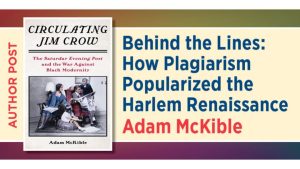Adam McKible, who earned his PhD in English from UNC in 1998, published a new book in February: Behind the Lines: How Plagiarism Popularized the Harlem Renaissance.
The book explores how an act of plagiarism in 1925 introduced the Harlem Renaissance to millions of Americans. In March 1925, Alain Locke published a special issue of the magazine Survey Graphic called “Harlem: Mecca of the New Negro.” Soon after, Locke organized the New Negro anthology, which scholars agree ushered in the Harlem Renaissance. McKible’s book focuses on how Chester T. Crowell plagiarized much of Locke’s material in another essay:
“But the contents of ‘Harlem: Mecca of the New Negro’ attracted their largest contemporary audience—of at least 2,414,308 readers—not through Locke’s initial work, but through the sort of plagiarism that would earn any student a painful visit to a college administrator. On August 8, 1925, just months after the appearance of the Harlem issue of the Survey Graphic, the Saturday Evening Post published an essay by Chester T. Crowell entitled ‘The World’s Largest Negro City.’ Crowell’s article is notable for at least two reasons: first, because he offers one of the very few representations of African Americans in the Saturday Evening Post that does not rely entirely on the anti-Black racist caricatures that were the Post’s typical fare and, second, because Crowell flagrantly stole much of his material from Locke’s issue—and he got away with it.”
“Nevertheless, Crowell’s intellectual thievery did introduce millions of Post readers to several core ideas in Locke’s Harlem issue, including the rise of Black cosmopolitanism and the concomitant development of a new political consciousness. And, stealing from Walter White’s Survey Graphic essay, ‘Color Lines,’ Crowell also touched on racial passing, a phenomenon that was facilitated by the urban anonymity afforded to some African Americans after they fled the South during the Great Migration. Rather than raise an alarm, however, Crowell suggested that the vibrancy of Harlem and a concomitant rise in racial pride makes passing for white less appealing for most African Americans—but this element of his argument may have largely fallen on deaf ears. The editorial board at the Newport News Daily Press, for example, saw only peril in a rising Harlem: ‘Every negro who thus ‘passes’ from his own race into the white race is liable to mix negro blood with Anglo-Saxon blood, and that is the danger to which the Anglo-Saxon clubs are calling attention and seeking to guard against. The real menace is in the ‘passing’ to which Mr. Crowell refers.’ Such antipathy toward interracial relations would have been familiar to regular Post readers, who not only consumed anti-Black fiction but were also fed a steady diet of anti-immigrant and white supremacist ideology in the magazine’s pages.”
In Behind the Lines, McKible writes about examples of this plagiarism and ultimately shows how “Locke’s work—through Crowell’s plagiarism—broke through the white noise of Lorimer’s [the white supremacist editor of the Saturday Evening Post] racist editorial practice and thus provided millions of readers with a more objective view of rising Black modernity in Jim Crow America.”
Read more about the book here.


